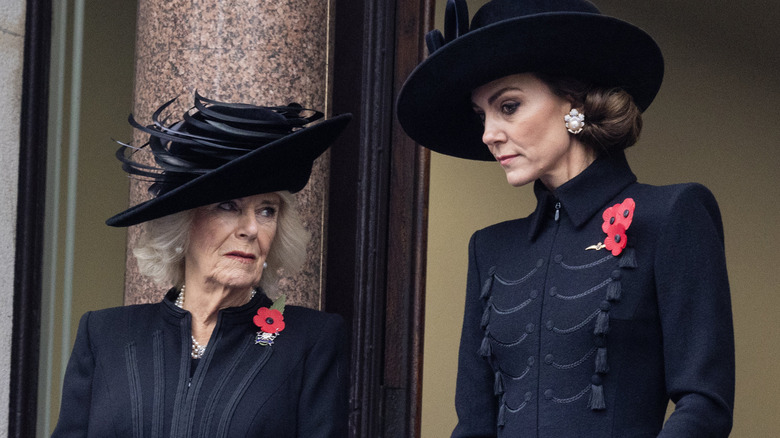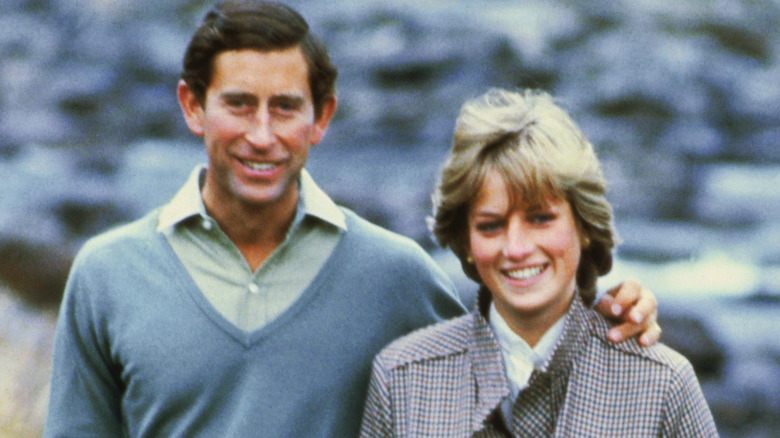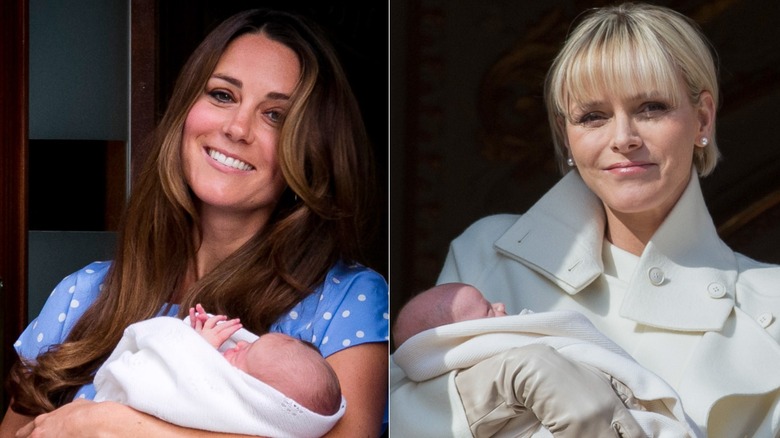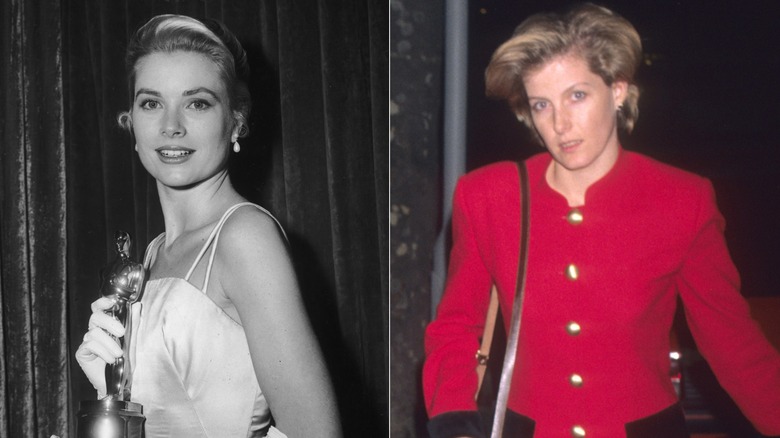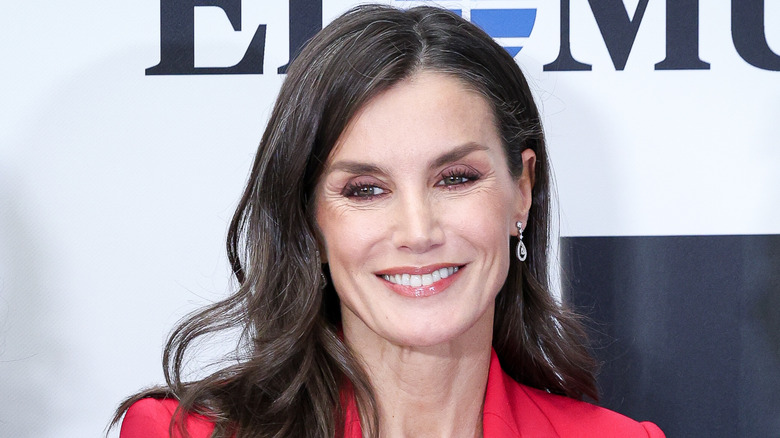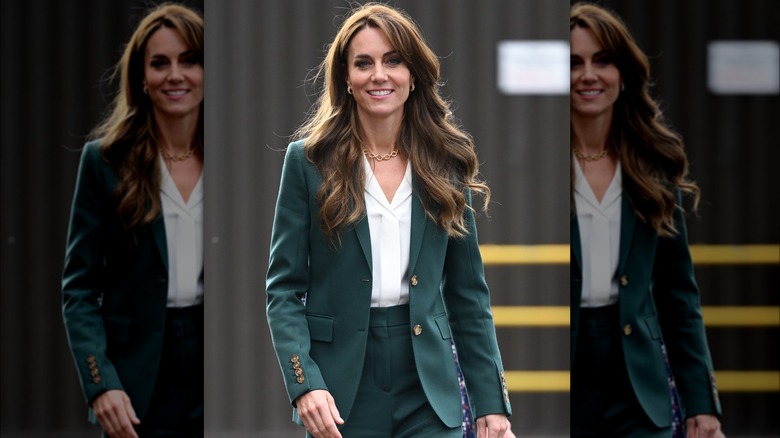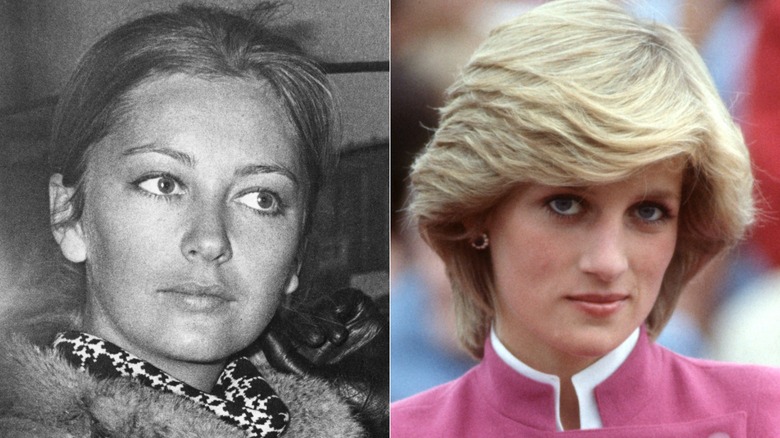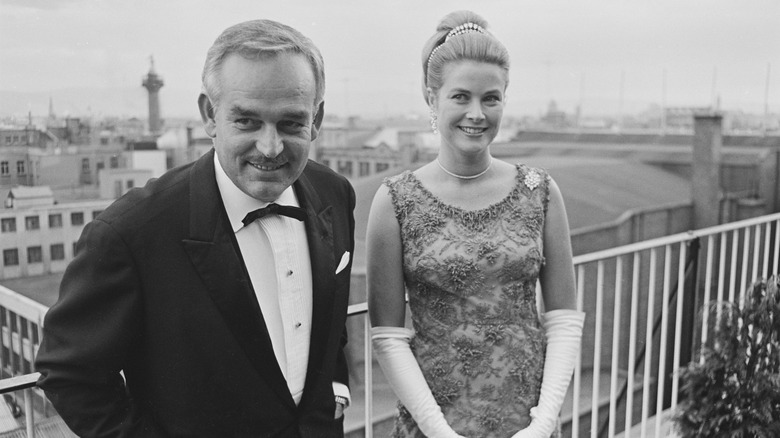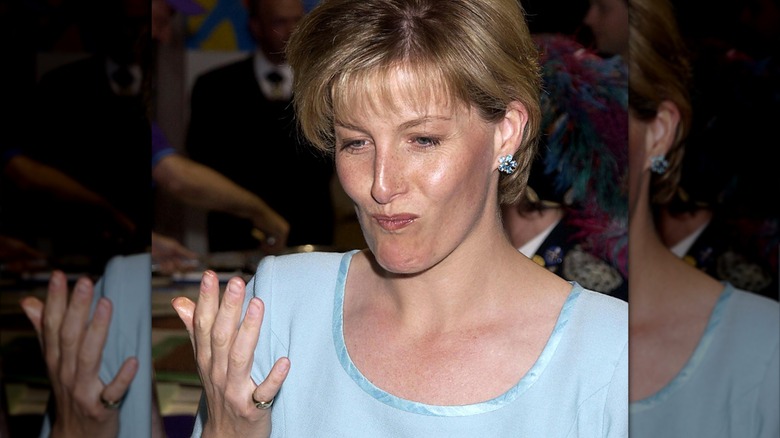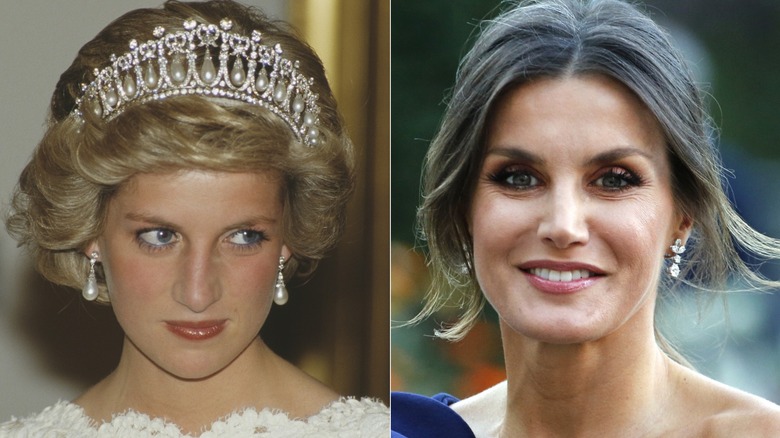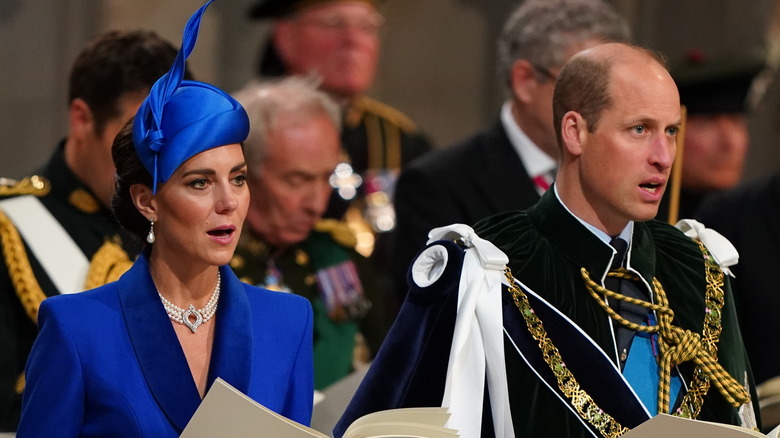The Disturbing Reality Of Being A Royal Wife
In 1643, spectators poured into the Venice Opera House to watch the very first performance of Claudio Monteverdi's "The Coronation of Poppea." As the plot unfolded, and the audience watched Emperor Nero's mistress, Poppea, steal the throne from Empress Ottavia, few could have imagined just how relevant this story would be almost exactly 350 years later. In Act I of the opera, Ottavia referred to herself as, "Wife and consort of Nero, deserted, unhappy woman" — words that somehow captured the way Princess Diana would feel in 1995 when she told Panorama, "There were three of us in this marriage" (via History).
While this might sound like an unusual coincidence, the truth is that history often repeats itself. Unhappy royal marriages were no less common in Monteverdi's time than Diana's. And, the years in-between have held plenty of horror stories of their own. In the 1840s, Queen Joséphine of Norway and Sweden watched as her husband, King Oscar I, maintained a second not-so-secret family. Per Peter Conradi's book, "Great Survivors," Joséphine's diary entries reveal her rage at having to endure this "in silence." Eight decades later, Queen Paola of Belgium remained silent upon discovering that her husband, too, had a secret daughter.
In that sense, Monteverdi's portrayal of Ottavia is timeless. Royal wives throughout history have been restrained by the ornamental nature of their roles. Oftentimes, they have been expected to endure infidelity, media scrutiny, and public humiliation — all with a stiff upper lip.
Royal wives are expected to embody purity
Nothing invokes the stuff of fairy tales quite like a royal romance, and yet the dynamics of these unique relationships are far more complex than they outwardly seem. Historically speaking, royal consorts were selected not based on true love, but on political necessity. As Peter Conradi explained in "Great Survivors," "Traditionally, royal marriages were not about love, lust, or friendship — they were instead about producing heirs and cementing alliances."
For this reason, royal wives have frequently been selected for their perceived levels of purity. The thought was that women with less sexual experience would somehow be less likely to cheat on the king — and potentially "tarnish" the royal bloodline with another man's child. This dynamic was evident when King Charles III first fell for Camilla, Queen Consort, in the 1970s. Because Camilla had a past, she was considered unsuitable for the throne. As Charles' late mentor, Lord Mountbatten, wrote in a 1974 letter, "For a wife, [you] should choose a suitable, attractive and sweet-charactered girl before she met anyone else she might fall for" (via Express). This advice, perhaps, inspired Charles to propose to the young, innocent-seeming Princess Diana instead.
Other young princes have faced similar predicaments upon selecting their brides. When Prince Haakon of Norway dared propose to a single mother, Mette-Marit Tjessem Høiby, in 2000, critics went wild. Spain's King Felipe also faced criticism for marrying Letizia Ortiz Rocasolano — a divorcée — in 2003.
They are pressured to produce an heir
As soon as royal wives enter the royal family, the pressure is on to produce an heir. Although this tradition dates back centuries, it remains fairly relevant in the modern day. Shortly after Prince William and Princess Catherine announced their engagement in 2010, conservative royal correspondent, James Whitaker, made sure to clarify this point to the bride-to-be. Writing in the Mirror, Whitaker advised Catherine, "Continue to look pretty and elegant (this is how you will be judged) and do masses of charity work. But most importantly, produce babies P.D.Q. (pretty da**ed quick). You need to produce an heir and also a spare. Good luck."
Luckily, Catherine did not have to wait long to welcome her first-born child. Prince George was born in 2013 — just two years after she and William tied the knot. However, not all royal brides have experienced such timely pregnancies.
After marrying Prince Albert of Monaco in 2011, Princess Charlene quite famously struggled to get pregnant. As reported by the French publication, Voici, at the time, the princess crumbled under all the pressure to produce an heir, instituting a palace-wide ban on the subject. When she did finally announce her pregnancy with twins Princess Gabriella and Prince Jacques in 2014, Charlene was met with disparaging comments. Reacting to the news of her pregnancy, one anonymous Monégasque citizen told the Daily Beast, "At least she has proved herself capable of reproducing."
Royal consorts must give up their careers
Although many royal wives had exciting professional lives before marrying into the monarchy, they were largely discouraged from pursuing their careers after becoming royalty. This was certainly true for the American actor and Academy Award winner, Grace Kelly, who became Princess Grace after marrying Prince Rainier of Monaco in 1956.
According to J. Randy Taraborrelli's book, "Once Upon a Time: Behind the Fairy Tale of Princess Grace and Prince Rainier," Grace believed that she would be able to continue acting after joining the princely family. Apparently, she told the reporter, Maurice Zolotow, "Why, there isn't anything to do in Monaco, you know? It's such a little country. Of course I'm going to continue with my work." Things, however, did not turn out this way, as Rainier seemed to oppose his wife's career ambitions. It was decided that Grace would retire from acting and that her movies would be banned from the principality.
Since then, many more royal wives have been pushed out of the workforce. Queen Letizia of Spain relinquished a prominent journalistic career to marry King Felipe, while Princess Charlene of Monaco traded her Olympic dreams for Prince Albert. In 1999, Sophie, Duchess of Edinburgh, tried to run her personal PR firm and "do it all" after marrying Prince Edward. However, she was forced to quit two years later when it became clear that there was a conflict of interest between her royal role and her professional ambitions.
Following protocol is a must
When royal wives walk away from their careers, they are also expected to take on a new role. This means following protocols — royal rules that dictate everything from the way a princess stirs her tea to the language she can use when referencing the bathroom. Although many princesses of the 20th century were born into their roles, the same cannot be said for most modern brides. Because of this, the royal wives of our era have struggled with this aspect of palace life.
In the Netflix documentary, "Harry & Meghan," Meghan Markle, Duchess of Sussex, confessed her surprise upon discovering the rules of curtsying to the late Queen Elizabeth II. "I just thought it was a joke," she said (via People). In a similar vein, Princess Charlene of Monaco once told the South African publication, Rapport, that she sometimes curtsies to the wrong person.
Of course, protocol is not just about manners. It also reaches other aspects of life — such as when it's appropriate to travel. This has supposedly been quite difficult for Spain's Queen Letizia, who was a traveling journalist before taking the throne. In the documentary, "Spain's Queen: From Journalist to Monarch," Letizia's former colleague, Sagrario Ruiz de Apodaca, said, "She was completely independent. And, it can't be easy for someone like that to become part of the royal family, to have to adhere to protocol. It was difficult for her to adapt and give up her freedoms."
Royal wives must dress properly or risk mockery
Although royal life is not always easy, princesses and queens almost always look their best. The reason is that, for many royal wives, dressing well is one of their unspoken duties. This was so true for Princess Catherine that she essentially underwent a full-fashion makeover when it became clear that Prince William was going to propose to her.
"Her clothing almost began to reflect what people saw in her character. A kind of restraint. A kind of modesty almost," said royal expert, Tom Quinn, in the documentary, "William and Kate: Too Good to Be True?" "And I think that did come about because William and Kate were moving towards the point where they would announce their engagement. And I think it was Kate starting to behave in ways which would be seen as more appropriate for a future queen."
While Catherine was able to use her clothing to project a more regal look, other royal wives have floundered under the pressure to look good. In an interview with Tatler, Princess Charlene of Monaco admitted that her first society event was a "baptism of fire." She explained, "I was used to living in a swimsuit and totally clueless about fashion. The day of the ball, I had been playing volleyball all day on the beach and didn't think about getting ready until late in the afternoon." Her outfit, a borrowed green dress, inspired mockery among the Monégasque elites.
They are often encouraged to turn a blind eye to infidelity
Although royal brides tend to project picture-perfect images to the public, their personal lives are not always so pretty. Throughout history, many queens and princesses have suffered their husbands' infidelity. Few had the chance to do anything about it.
This was certainly the case for Princess Diana, who was encouraged to accept King Charles III's extra-marital affairs even prior to the couple's marriage. In a series of tapes that Diana recorded for her biographer, Andrew Morton, Diana said that she learned about Charles' romance with Camilla Parker-Bowles during their engagement. Apparently, the princess was so upset that she considered calling off the wedding. She recalled, "I said, 'I can't marry him. I can't do this." Unfortunately, however, Diana was discouraged from breaking off the engagement due to Charles' princely position. Her sisters apparently told her, "Bad luck, Dutch. Your face is on the tea towel, so you're too late to chicken out."
Twenty years earlier, Queen Paola of Belgium — then just a princess — found herself in a similar situation when her husband, King Albert II, welcomed a love child with Baroness Sybille de Selys Longchamps. Upon discovering the news, Paola was said to have been desperate for a divorce. However, a report in Vanity Fair indicates that the then-monarch, King Baudouin, may have discouraged Paola from filing the paperwork, even threatening to take away her children if she didn't comply.
Divorce is only rarely an option
As Queen Paola likely discovered, divorce is not always in the cards for European royal consorts — even when infidelity is involved. The reasons for this are varied, although it is certainly true that Paola was not the only royal woman who stayed married for the sake of her children.
Princess Grace of Monaco may have also felt forced to remain married in order to maintain access to her three kids. As J. Randy Taraborrelli noted in, "Once Upon A Time: Behind the Fairy Tale of Princess Grace and Prince Rainier," it would have been impossible for the Hollywood actress-turned-royal to have won a custody battle against Prince Rainier. He wrote, "Grace couldn't very well change her mind about her marriage ... Divorce would mean losing her children. Such was the law of the land, as it had been for centuries."
Of course, there are other reasons why royal families try to separate themselves from instances of divorce. In Britain, these sorts of proceedings have a history of putting the monarchy at risk. In 1936, when Wallis Simpson was granted a divorce to marry King Edward VIII, the country suffered a constitutional crisis that led to Edward's abdication and exile. When King Charles III and Princess Diana got divorced in 1996, the future monarch saw his approval ratings plummet rather permanently. This pattern shows that it would be difficult for Prince William and Princess Catherine to separate without putting the crown at risk.
The media criticism is constant
A royal wife's job is to smile for the cameras, but the cameras don't always smile back. Thanks to a vast amount of press criticism, many highly-ranked women have struggled to protect their public image. When Sophie, Duchess of Edinburgh, started going out with Prince Edward in the 1990s, she was attacked for being a Princess Diana "wanna-be." With her short blond hair and bright blue eyes, Sophie could not help but look a little like the Princess of Wales — a fact that entertained the media for years. As late as 2001, a piece in the Daily Mail poked fun at the royal newcomer, writing, "You really have to wonder just how much a study Sophie has made of Diana's life."
While the press cast Sophie as a "fausse" Diana, other royal wives were bullied even more severely. Sarah Ferguson, Duchess of York, told The Observer that tabloid criticism of her weight was so severe that it led her to develop an eating disorder. "It took my opinion of myself to absolutely nothing, a piece of dirt" (via The Guardian).
Princess Charlene of Monaco struggled so much with the critical media coverage of her wedding that she started crying at the end of the ceremony. After the fact, she told The Times, "Everything was just so overwhelming and there were all the mixed emotions because of the rumors, and obviously all this tension built up and I burst into tears."
Ex-boyfriends can come crawling out of the woodwork
As bad as the media criticism may be, it is hardly the only threat to a royal wife's reputation. Over the years, many royal brides have watched their ex-boyfriends and lovers humiliate them on the public stage. For both Princess Diana and Queen Letizia of Spain, this meant witnessing their exes write books about their relationships.
In 1994, Diana watched on as her former lover, James Hewitt, published "Princess in Love" — a tell-all piece that described many of the most intimate moments of their romance. Written in collaboration with journalist, Anna Pasternak, the tome delved into Diana's mental health struggles, even sharing the private details of her battle with bulimia. Shortly after the work was published, a source close to Diana told People, that the princess was "bitterly hurt" by Hewitt's betrayal.
More than 20 years later, Letizia went through something similar when her ex-husband, Alonso Guerrero Pérez, published a book titled, "The Love of Penny Robinson." Although the tome was considered a work of fiction, it seemed autobiographical in nature. After all, the main character, who was also named Alonso, watched his ex-wife become the queen of Spain. Far from being humorous, though, the book contained graphic descriptions of the "main character" taking nude photos of the queen-to-be. Luckily, no photographs of the queen were leaked — although the same could not be said for Sophie, Duchess of Edinburgh, whose ex-boyfriend sold her nudes to The Sun in 1999.
Royal brides must put their husbands first
One of the main reasons that royal wives have such a difficult time is that they must always put the needs of the monarchy above their own. In many cases, this means prioritizing the king and his wishes over all else. Camilla, Queen Consort, and King Charles III have been known to follow this model — and it seems to work for them. As royal expert, Robert Lacey, relayed in his book, "Battle of the Brothers," "Camilla had confided to Kate the secret of hanging on to a busy prince: fit your timetable — well, basically your whole life — around his" (via Mirror).
Although this philosophy might sound a bit out-of-date, many royal wives still live by it. One of the most extreme examples of this occurred in 2011 when Princess Charlene of Monaco had to base her honeymoon plans around Prince Albert's busy work schedule. During what was supposed to be the pair's romantic South African getaway, Albert attended meetings with the Olympic Committee. The Prince's Palace of Monaco even confirmed to ABC that the night before the reunion, the prince slept miles away from his new bride to be closer to his work commitments. This instance illustrates the reality that, for many royal brides, the crown comes before one's personal happiness.
